Application of Predictive Control in Scheduling of Domestic Appliances
Abstract
1. Introduction
2. Research Contribution
3. System Architecture and Modeling
3.1. Load Categorization
3.1.1. Thermal Load
3.1.2. Non-Thermal Load
- Preemptive—The appliance can be paused or interrupted whenever needed.
- Fixed duration—The appliance run for a fixed duration () to finish the task assigned to it.
- Deadline—The appliance has a deadline associated by which it needs to finish the task assigned to the appliance. The deadline is chosen by the user and cannot be smaller than the running duration of the appliance which is an operational constraint [44]. Examples include washing machine, clothes dryer, dishwasher, etc.
3.2. System Layout
- The first component of the HEMS is the forecaster. It is deputized to make predictions about the external weather and the heat-gains due to solar irradiance in the house. Data-driven prediction techniques [46,47] are commonly used to make these predictions based on available historical data about the variable. The second component of the HEMS uses these predictions to optimally schedule the thermal appliances.
- The second and the key component of the HEMS is the Predictive MILP controller. This component operates in two MOO, which is determined automatically within the component based upon the electrical load categories (see Section 3.1). In each mode, a different mathematical optimization problem is solved by exploiting the predictions made by the forecaster about the weather conditions. The electricity prices and the consumption-capacity profile is provided to HEMS by the smart-grid operator using smart-meter communication.
3.3. Appliance Dynamics Modeling and Setup
3.3.1. State-Space Model
3.3.2. Thermal Load Appliances Modeling
3.3.3. Non-Thermal Load Appliances Modeling
4. Problem Formulation and Scheduling Algorithm
4.1. Energy Cost of Thermal Appliances
4.2. Comfort Zone Constraints of Thermal Appliances
4.3. Maximum Power Consumption Constraint of Thermal Appliances
4.4. Energy Cost of Non-Thermal Appliances
4.5. Deadline Constraint of Non-Thermal Appliances
4.6. The Non-Thermal Appliance Start-Up Cost
4.7. Operation Time Constraint of Non-Thermal Appliances
4.8. Total Capacity Constraint
4.9. Soft Constraints
4.10. Scheduling Algorithm
4.10.1. Mode 1
4.10.2. Mode 2
5. Simulation Studies
5.1. Simulation Setup
5.2. Results and Discussion
5.2.1. Without HEMS and Linear Quadratic Regulation (LQR) Control for Thermal Appliances
5.2.2. Without HEMS and MPC Control for Thermal Appliances
5.2.3. With HEMS
5.3. Computation Time of HEMS
6. Conclusions
Author Contributions
Funding
Conflicts of Interest
References
- Pérez-Lombard, L.; Ortiz, J.; Pout, C. A review on buildings energy consumption information. Energy Build. 2008, 40, 394–398. [Google Scholar] [CrossRef]
- Andersen, P.B.; Hauksson, E.B.; Pedersen, A.B.; Gantenbein, D.; Jansen, B.; Andersen, C.A.; Dall, J. Smart Grid Applications, Communications, and Security; Wiley-VCH: Weinheim, Germany, 2012. [Google Scholar]
- Strbac, G. Demand side management: Benefits and challenges. Energy Policy 2008, 36, 4419–4426. [Google Scholar] [CrossRef]
- Albadi, M.H.; El-Saadany, E. Demand response in electricity markets: An overview. In Proceedings of the 2007 IEEE Power Engineering Society General Meeting, Tampa, FL, USA, 24–28 June 2007. [Google Scholar]
- Palensky, P.; Dietrich, D. Demand side management: Demand response, intelligent energy systems, and smart loads. IEEE Trans. Ind. Inform. 2011, 7, 381–388. [Google Scholar] [CrossRef]
- Brambley, M.R.; Hansen, D.; Haves, P.; Holmberg, D.; McDonald, S.; Roth, K.; Torcellini, P. Advanced sensors and controls for building applications: Market assessment and potential R&D pathways. Pac. Northwest Natl. Lab. 2005. [Google Scholar] [CrossRef]
- Stankovic, J.A. Real-Time Computing System: The Next Generation; University of Massachusetts: Amherst, MA, USA, 1988. [Google Scholar]
- De Angelis, F.; Boaro, M.; Fuselli, D.; Squartini, S.; Piazza, F.; Wei, Q. Optimal home energy management under dynamic electrical and thermal constraints. IEEE Trans. Ind. Inform. 2013, 9, 1518–1527. [Google Scholar] [CrossRef]
- Adika, C.O.; Wang, L. Autonomous appliance scheduling for household energy management. IEEE Trans. Smart Grid 2014, 5, 673–682. [Google Scholar] [CrossRef]
- Mohsenian-Rad, A.H.; Leon-Garcia, A. Optimal residential load control with price prediction in real-time electricity pricing environments. IEEE Trans. Smart Grid 2010, 1, 120–133. [Google Scholar] [CrossRef]
- Setlhaolo, D.; Xia, X. Optimal scheduling of household appliances with a battery storage system and coordination. Energy Build. 2015, 94, 61–70. [Google Scholar] [CrossRef]
- Paterakis, N.G.; Erdinc, O.; Bakirtzis, A.G.; Catalão, J.P. Optimal household appliances scheduling under day-ahead pricing and load-shaping demand response strategies. IEEE Trans. Ind. Inform. 2015, 11, 1509–1519. [Google Scholar] [CrossRef]
- Shirazi, E.; Jadid, S. Optimal residential appliance scheduling under dynamic pricing scheme via HEMDAS. Energy Build. 2015, 93, 40–49. [Google Scholar] [CrossRef]
- Sou, K.C.; Weimer, J.; Sandberg, H.; Johansson, K.H. Scheduling smart home appliances using mixed integer linear programming. In Proceedings of the 2011 50th IEEE Conference on Decision and Control and European Control Conference, Orlando, FL, USA, 12–15 December 2011; pp. 5144–5149. [Google Scholar]
- Shirazi, E.; Zakariazadeh, A.; Jadid, S. Optimal joint scheduling of electrical and thermal appliances in a smart home environment. Energy Convers. Manag. 2015, 106, 181–193. [Google Scholar] [CrossRef]
- Paridari, K.; Parisio, A.; Sandberg, H.; Johansson, K.H. Robust Scheduling of Smart Appliances in Active Apartments With User Behavior Uncertainty. IEEE Trans. Autom. Sci. Eng. 2016, 13, 247–259. [Google Scholar] [CrossRef]
- Wu, X.; Hu, X.; Yin, X.; Moura, S. Stochastic optimal energy management of smart home with PEV energy storage. IEEE Trans. Smart Grid 2016, 9, 2065–2075. [Google Scholar] [CrossRef]
- Matallanas, E.; Castillo-Cagigal, M.; Gutiérrez, A.; Monasterio-Huelin, F.; Caamaño-Martín, E.; Masa, D.; Jiménez-Leube, J. Neural network controller for active demand-side management with PV energy in the residential sector. Appl. Energy 2012, 91, 90–97. [Google Scholar] [CrossRef]
- Soares, A.; Antunes, C.H.; Oliveira, C.; Gomes, Á. A multi-objective genetic approach to domestic load scheduling in an energy management system. Energy 2014, 77, 144–152. [Google Scholar] [CrossRef]
- Graditi, G.; Di Silvestre, M.L.; Gallea, R.; Sanseverino, E.R. Heuristic-based shiftable loads optimal management in smart micro-grids. IEEE Trans. Ind. Inform. 2015, 11, 271–280. [Google Scholar] [CrossRef]
- Logenthiran, T.; Srinivasan, D.; Shun, T.Z. Demand side management in smart grid using heuristic optimization. IEEE Trans. Smart Grid 2012, 3, 1244–1252. [Google Scholar] [CrossRef]
- Aslam, S.; Iqbal, Z.; Javaid, N.; Khan, Z.; Aurangzeb, K.; Haider, S. Towards efficient energy management of smart buildings exploiting heuristic optimization with real time and critical peak pricing schemes. Energies 2017, 10, 2065. [Google Scholar] [CrossRef]
- Gutierrez-Martinez, V.J.; Moreno-Bautista, C.A.; Lozano-Garcia, J.M.; Pizano-Martinez, A.; Zamora-Cardentas, E.A.; Gomez-Martinez, M.A. A Heuristic Home Electric Energy Management System Considering Renewable Energy Availability. Energies 2019, 12, 671. [Google Scholar] [CrossRef]
- Meng, F.L.; Zeng, X.J. A bilevel optimization approach to demand response management for the smart grid. In Proceedings of the 2016 IEEE Congress on Evolutionary Computation (CEC), Vancouver, BC, Canada, 24–29 July 2016; pp. 287–294. [Google Scholar]
- Chen, C.; Kishore, S.; Snyder, L.V. An innovative RTP-based residential power scheduling scheme for smart grids. In Proceedings of the 2011 IEEE International Conference on Acoustics, Speech and Signal Processing (ICASSP), Prague, Czech Republic, 22–27 May 2011; pp. 5956–5959. [Google Scholar]
- Zhang, D.; Li, S.; Sun, M.; O’Neill, Z. An optimal and learning-based demand response and home energy management system. IEEE Trans. Smart Grid 2016, 7, 1790–1801. [Google Scholar] [CrossRef]
- Ozturk, Y.; Senthilkumar, D.; Kumar, S.; Lee, G.K. An Intelligent Home Energy Management System to Improve Demand Response. IEEE Trans. Smart Grid 2013, 4, 694–701. [Google Scholar] [CrossRef]
- Setlhaolo, D.; Xia, X.; Zhang, J. Optimal scheduling of household appliances for demand response. Electr. Power Syst. Res. 2014, 116, 24–28. [Google Scholar] [CrossRef]
- Haider, H.T.; See, O.H.; Elmenreich, W. Dynamic residential load scheduling based on adaptive consumption level pricing scheme. Electr. Power Syst. Res. 2016, 133, 27–35. [Google Scholar] [CrossRef]
- Pipattanasomporn, M.; Kuzlu, M.; Rahman, S. An algorithm for intelligent home energy management and demand response analysis. IEEE Trans. Smart Grid 2012, 3, 2166–2173. [Google Scholar] [CrossRef]
- Costanzo, G.T.; Zhu, G.; Anjos, M.F.; Savard, G. A system architecture for autonomous demand side load management in smart buildings. IEEE Trans. Smart Grid 2012, 3, 2157–2165. [Google Scholar] [CrossRef]
- Rastegar, M.; Fotuhi-Firuzabad, M.; Zareipour, H. Home energy management incorporating operational priority of appliances. Int. J. Electr. Power Energy Syst. 2016, 74, 286–292. [Google Scholar] [CrossRef]
- Garcia, C.E.; Prett, D.M.; Morari, M. Model predictive control: Theory and practice—A survey. Automatica 1989, 25, 335–348. [Google Scholar] [CrossRef]
- Ma, J.; Qin, J.; Salsbury, T.; Xu, P. Demand reduction in building energy systems based on economic model predictive control. Chem. Eng. Sci. 2012, 67, 92–100. [Google Scholar] [CrossRef]
- Oldewurtel, F.; Ulbig, A.; Parisio, A.; Andersson, G.; Morari, M. Reducing peak electricity demand in building climate control using real-time pricing and model predictive control. In Proceedings of the 49th IEEE Conference on Decision and Control (CDC), Atlanta, GA, USA, 15–17 December 2010; pp. 1927–1932. [Google Scholar]
- Bianchini, G.; Casini, M.; Vicino, A.; Zarrilli, D. Demand-response in building heating systems: A Model Predictive Control approach. Appl. Energy 2016, 168, 159–170. [Google Scholar] [CrossRef]
- Li, K.; Wenping, X.; Xu, C.; Mao, H. A multiple model approach for predictive control of indoor thermal environment with high resolution. J. Build. Perform. Simul. 2018, 11, 164–178. [Google Scholar] [CrossRef]
- Corbin, C.; Henze, G. Predictive control of residential HVAC and its impact on the grid. Part II: Simulation studies of residential HVAC as a supply following resource. J. Build. Perform. Simul. 2017, 10, 365–377. [Google Scholar] [CrossRef]
- Pedersen, T.H.; Petersen, S. Investigating the performance of scenario-based model predictive control of space heating in residential buildings. J. Build. Perform. Simul. 2018, 11, 485–498. [Google Scholar] [CrossRef]
- Zhang, Y.; Zhang, T.; Wang, R.; Liu, Y.; Guo, B. Optimal operation of a smart residential microgrid based on model predictive control by considering uncertainties and storage impacts. Sol. Energy 2015, 122, 1052–1065. [Google Scholar] [CrossRef]
- Zhang, Y.; Wang, R.; Zhang, T.; Liu, Y.; Guo, B. Model predictive control-based operation management for a residential microgrid with considering forecast uncertainties and demand response strategies. IET Gener. Transm. Distrib. 2016, 10, 2367–2378. [Google Scholar] [CrossRef]
- Parisio, A.; Rikos, E.; Tzamalis, G.; Glielmo, L. Use of model predictive control for experimental microgrid optimization. Appl. Energy 2014, 115, 37–46. [Google Scholar] [CrossRef]
- Pascual, J.; Barricarte, J.; Sanchis, P.; Marroyo, L. Energy management strategy for a renewable-based residential microgrid with generation and demand forecasting. Appl. Energy 2015, 158, 12–25. [Google Scholar] [CrossRef]
- Chen, C.; Wang, J.; Heo, Y.; Kishore, S. MPC-based appliance scheduling for residential building energy management controller. IEEE Trans. Smart Grid 2013, 4, 1401–1410. [Google Scholar] [CrossRef]
- Rahmani-Andebili, M. Scheduling deferrable appliances and energy resources of a smart home applying multi-time scale stochastic model predictive control. Sustain. Cities Soc. 2017, 32, 338–347. [Google Scholar] [CrossRef]
- Hammer, A.; Heinemann, D.; Lorenz, E.; Lückehe, B. Short-term forecasting of solar radiation: A statistical approach using satellite data. Sol. Energy 1999, 67, 139–150. [Google Scholar] [CrossRef]
- Mellit, A.; Pavan, A.M. A 24-h forecast of solar irradiance using artificial neural network: Application for performance prediction of a grid-connected PV plant at Trieste, Italy. Sol. Energy 2010, 84, 807–821. [Google Scholar] [CrossRef]
- Brogan, W.L. Modern Control Theory; Pearson Education India: New Delhi, India, 1982. [Google Scholar]
- Halvgaard, R.; Poulsen, N.K.; Madsen, H.; Jørgensen, J.B. Economic model predictive control for building climate control in a smart grid. In Proceedings of the 2012 IEEE PES Innovative Smart Grid Technologies (ISGT), Washington, DC, USA, 16–20 January 2012; pp. 1–6. [Google Scholar]
- Staino, A.; Nagpal, H.; Basu, B. Cooperative optimization of building energy systems in an economic model predictive control framework. Energy Build. 2016, 128, 713–722. [Google Scholar] [CrossRef]
- Halvgaard, R.; Bacher, P.; Perers, B.; Andersen, E.; Furbo, S.; Jørgensen, J.B.; Poulsen, N.K.; Madsen, H. Model predictive control for a smart solar tank based on weather and consumption forecasts. Energy Procedia 2012, 30, 270–278. [Google Scholar] [CrossRef]
- Jordan, U.; Vajen, K. DHWcalc: Program to generate domestic hot water profiles with statistical means for user defined conditions. In Proceedings of the ISES Solar World Congress, Orlando, FL, USA, 8–12 August 2005; pp. 8–12. [Google Scholar]
- Energy Plus Energy Simulation Software-International Weather for Energy. Calculations (IWEC) Data for Ireland. Available online: http://apps1.eere.energy.gov/buildings/energyplus/cfm/weather_data3.cfm/region=6_europe_wmo_region_6/country=IRL/cname=Ireland (accessed on 30 December 2019).
- Danish Electricity Wholesale Market. Available online: http://www.energinet.dk/EN/El/Engrosmarked/Sider/default.aspx (accessed on 20 June 2018).
- Löfberg, J. YALMIP: A Toolbox for Modeling and Optimization in MATLAB. In Proceedings of the 2004 IEEE International Conference on Robotics and Automation (IEEE Cat. No.04CH37508), New Orleans, LA, USA, 2–4 September 2004. [Google Scholar]
- Vatu, R.; Seritan, G.; Ceaki, O.; Mancasi, M. Microgrids operation improvement using storage technologies. In Proceedings of the 2017 10th International Symposium on Advanced Topics in Electrical Engineering (ATEE), Bucharest, Romania, 23–25 March 2017; pp. 791–796. [Google Scholar]
- Enescu, D.; Chicco, G.; Porumb, R.; Seritan, G. Thermal Energy Storage for Grid Applications: Current Status and Emerging Trends. Energies 2020, 13, 340. [Google Scholar] [CrossRef]
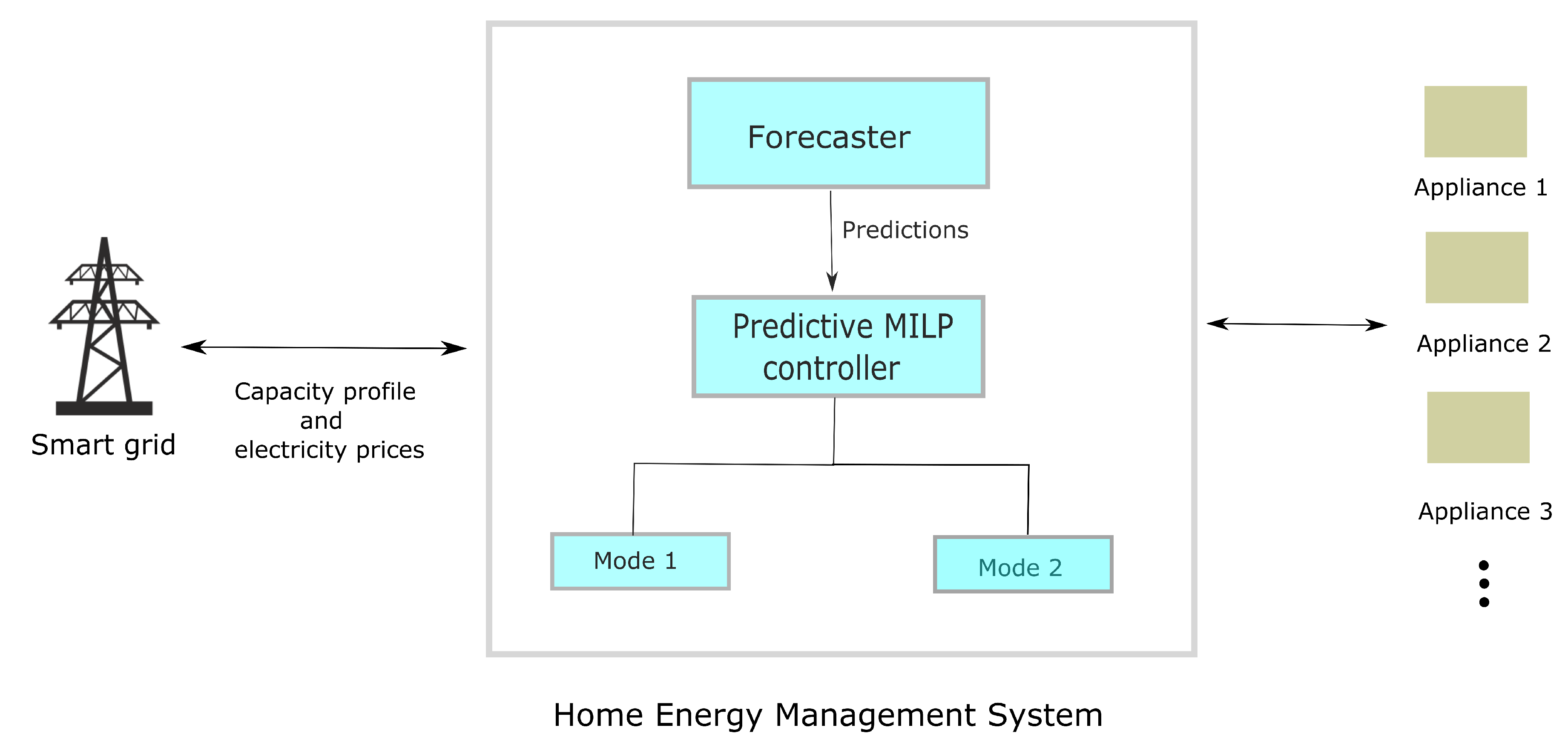
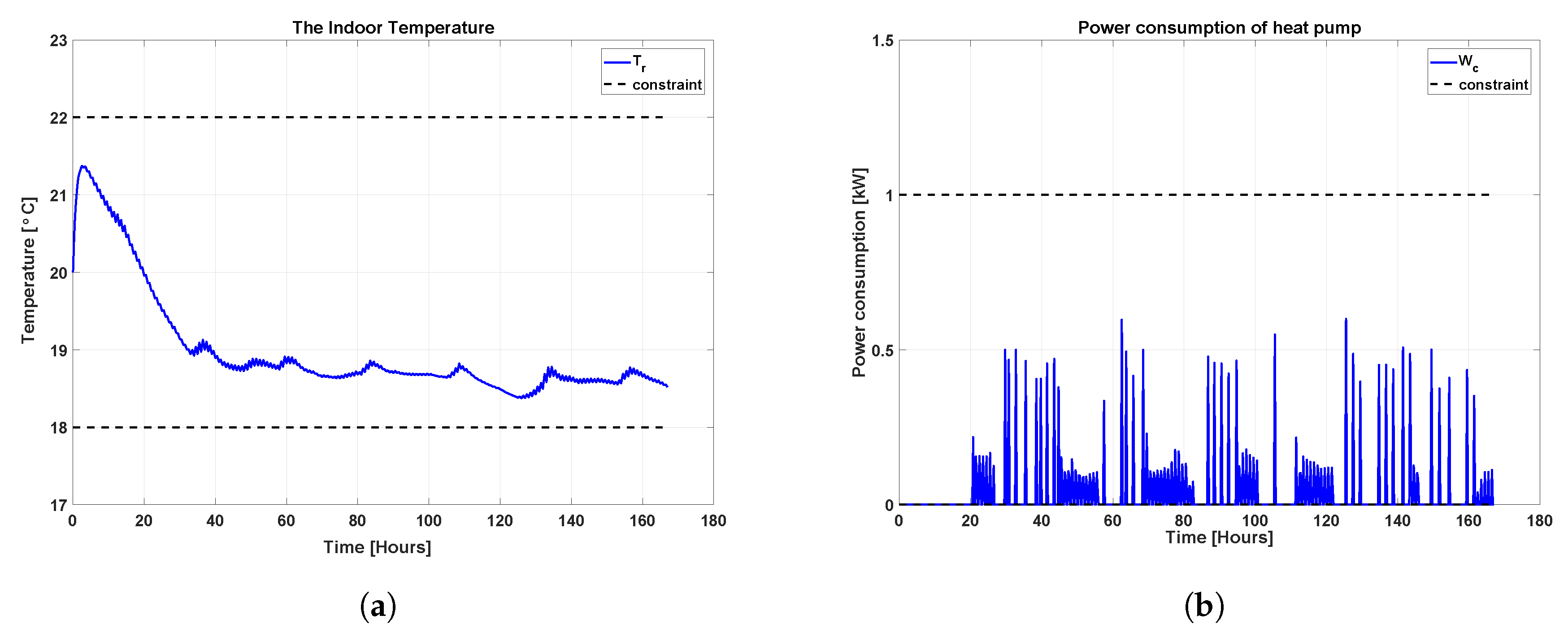
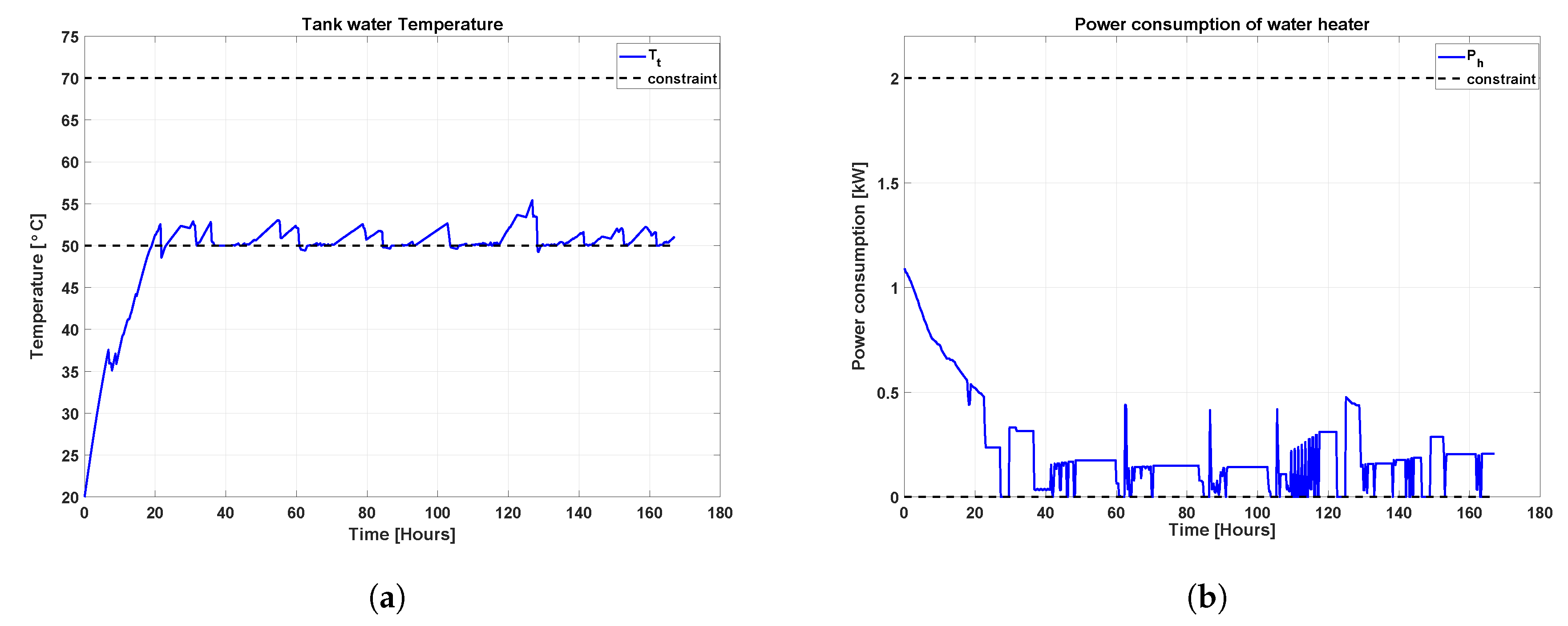
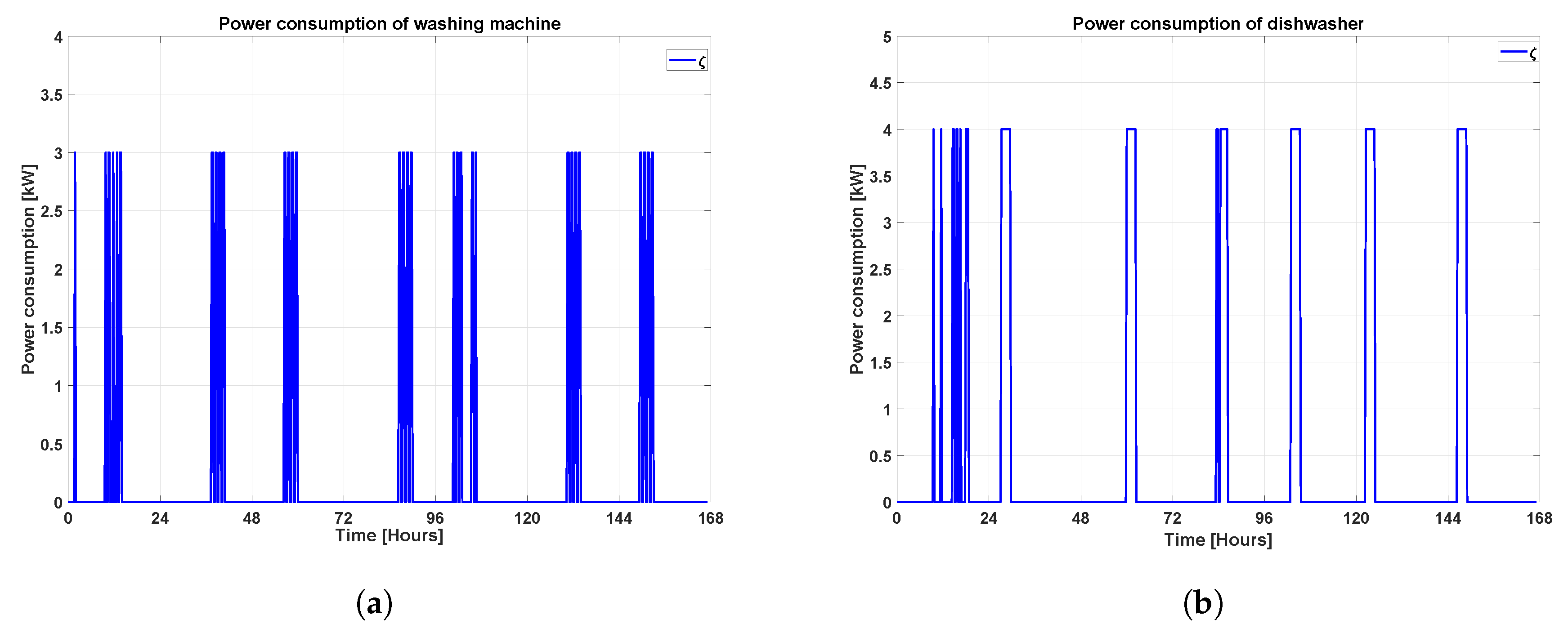
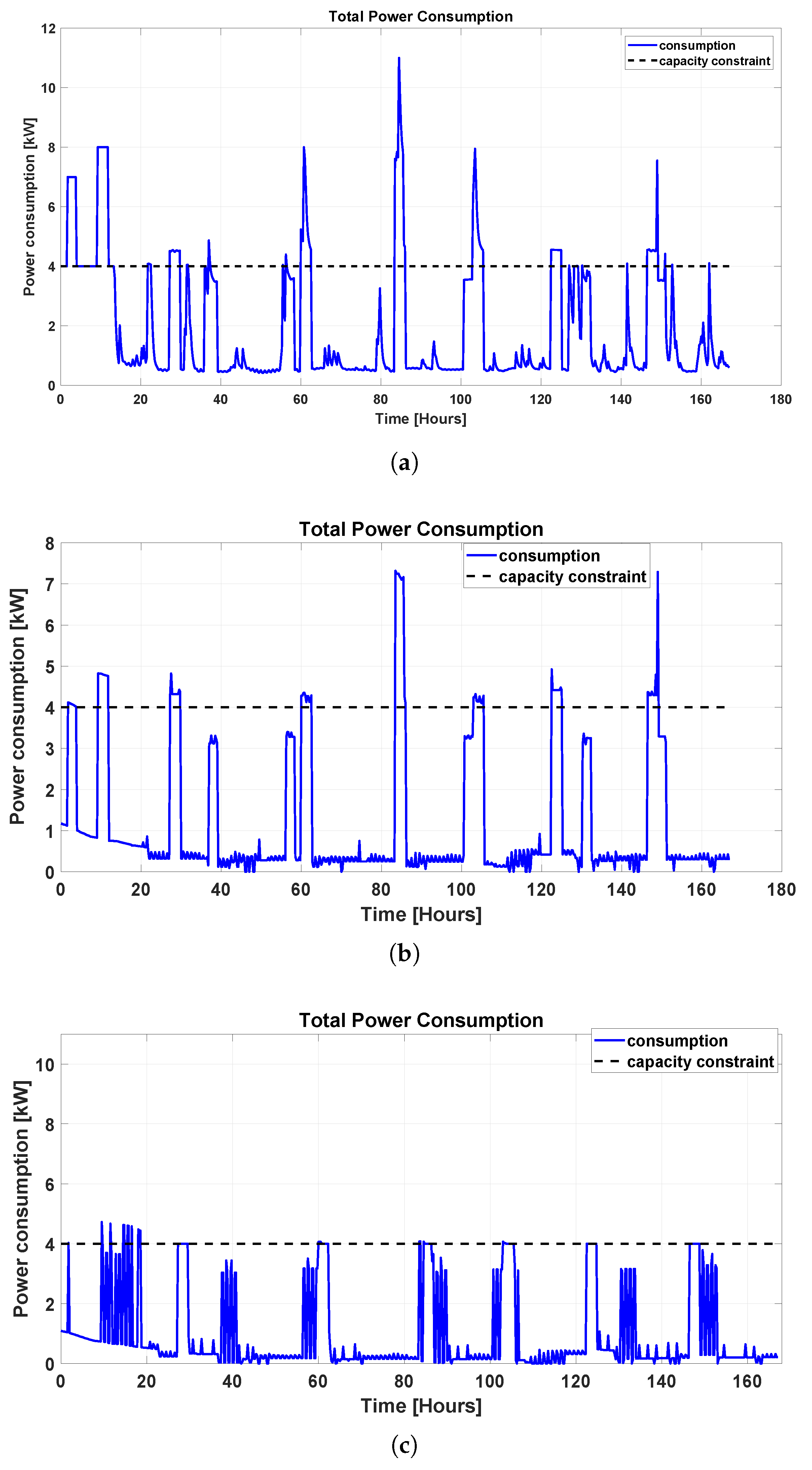
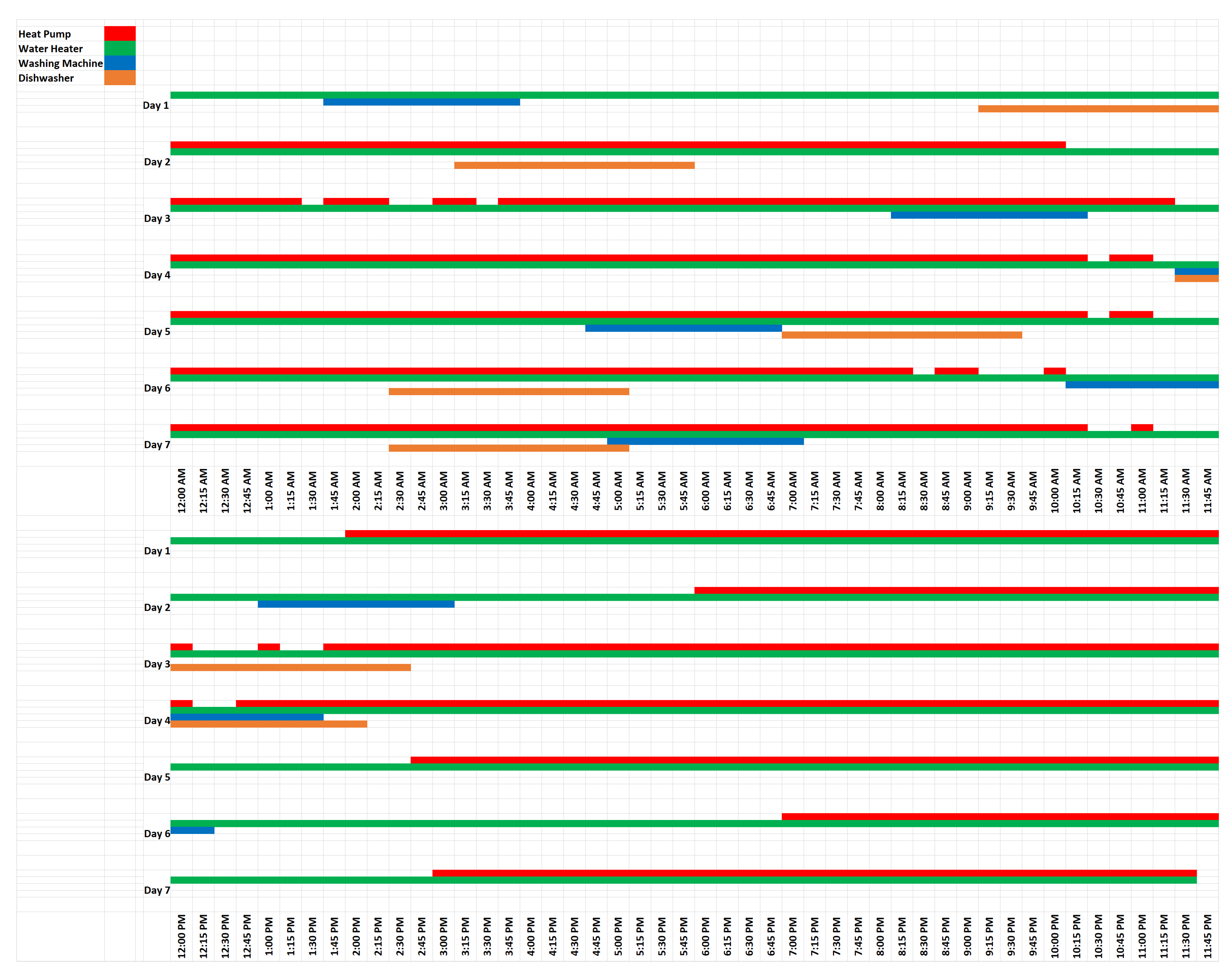
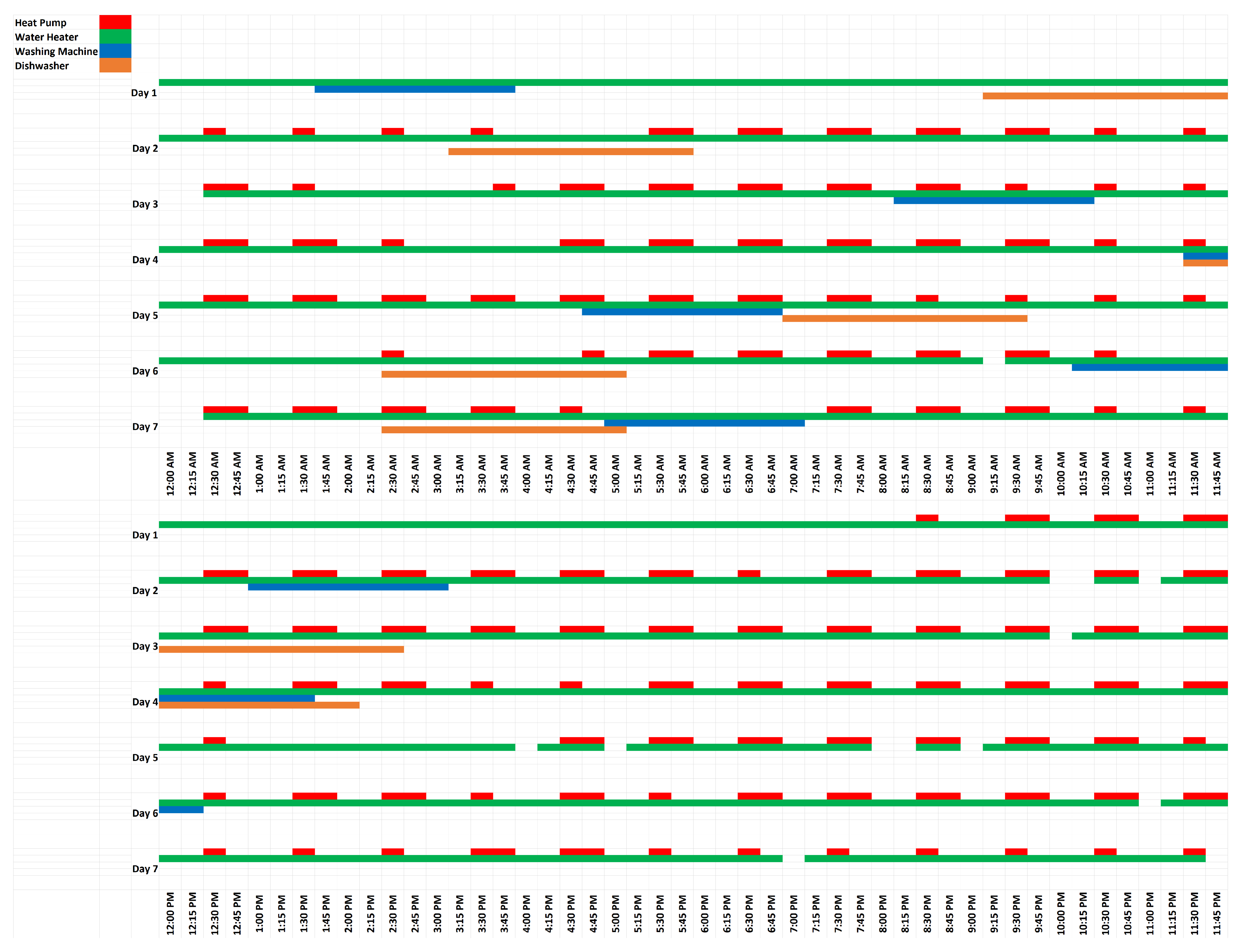
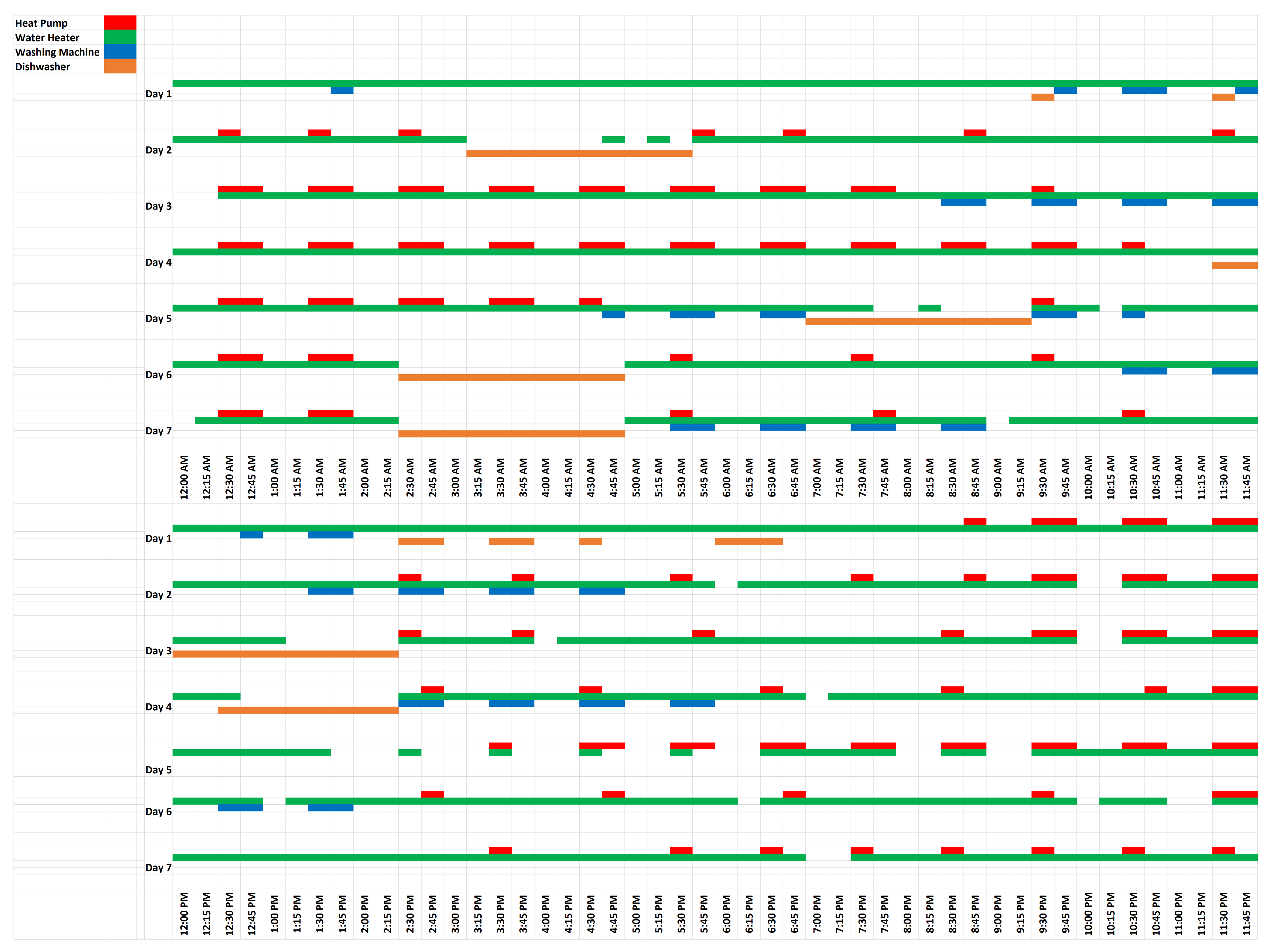
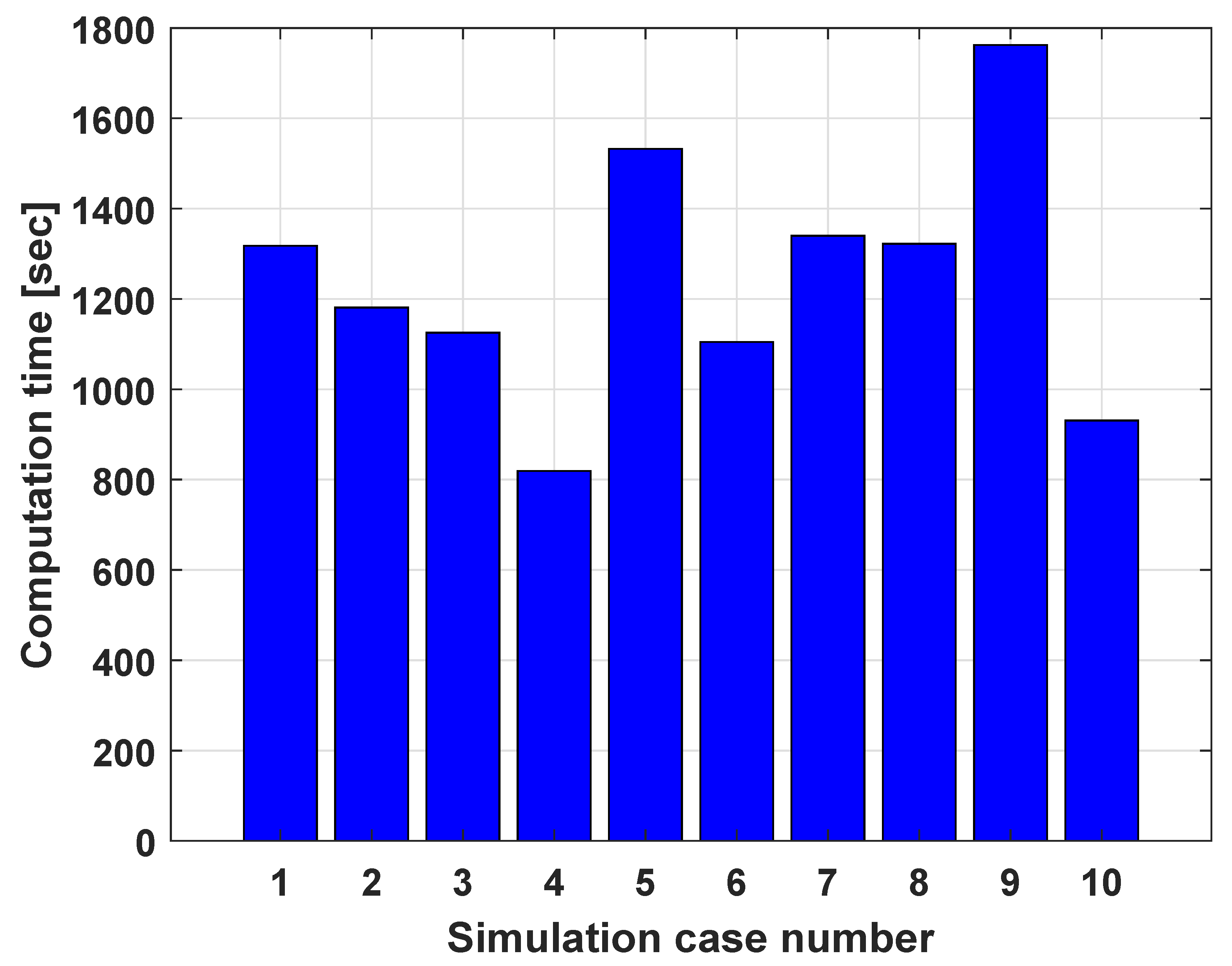
| Parameter | Value | Unit | Parameter | Value | Unit |
|---|---|---|---|---|---|
| 3315 | kJ/C | 624 | kJ/Ch | ||
| 810 | kJ/C | 28 | kJ/Ch | ||
| 836 | kJ/C | 28 | kJ/Ch | ||
| 3881.3 | kJ/C | 29.84 | kJ/Ch | ||
| 3 | - | p | 0.2 | - | |
| 1 | - |
| Appliance | Running Time () | Rated-Power (P) |
|---|---|---|
| Washing machine | 2 h | 3 kW |
| Dishwasher | 2.5 h | 4 kW |
| Mode | Number of Constraints | Optimization Problem |
|---|---|---|
| Mode 1 (washing machine) | 7003 | Mixed Integer Linear Program |
| Mode 1 (dryer) | 7003 | Mixed Integer Linear Program |
| Mode 1 (washing machine and dryer) | 7290 | Mixed Integer Linear Program |
| Mode 2 | 6716 | Linear program |
| Case | Electricity Cost (€) |
|---|---|
| Without HEMS and LQR control | 15.14 |
| Without HEMS and MPC control | 8.2005 |
| With HEMS | 4.4934 |
| Case | Overconsumption (kW) | Peak-Power Consumption (kW) |
|---|---|---|
| Without HEMS and LQR control | 172 | 12.98 |
| Without HEMS and MPC control | 59.8947 | 7.3 |
| With HEMS | 6.4062 | 4.7285 |
| Case | Peak-Power Consumption (kW) | Mean-Power Consumption (kW) | PAR |
|---|---|---|---|
| Without HEMS and LQR control | 11 | 1.88 | 5.82 |
| Without HEMS and MPC control | 7.31 | 1.10 | 6.65 |
| With HEMS | 4.7285 | 0.937 | 5.04 |
© 2020 by the authors. Licensee MDPI, Basel, Switzerland. This article is an open access article distributed under the terms and conditions of the Creative Commons Attribution (CC BY) license (http://creativecommons.org/licenses/by/4.0/).
Share and Cite
Nagpal, H.; Staino, A.; Basu, B. Application of Predictive Control in Scheduling of Domestic Appliances. Appl. Sci. 2020, 10, 1627. https://doi.org/10.3390/app10051627
Nagpal H, Staino A, Basu B. Application of Predictive Control in Scheduling of Domestic Appliances. Applied Sciences. 2020; 10(5):1627. https://doi.org/10.3390/app10051627
Chicago/Turabian StyleNagpal, Himanshu, Andrea Staino, and Biswajit Basu. 2020. "Application of Predictive Control in Scheduling of Domestic Appliances" Applied Sciences 10, no. 5: 1627. https://doi.org/10.3390/app10051627
APA StyleNagpal, H., Staino, A., & Basu, B. (2020). Application of Predictive Control in Scheduling of Domestic Appliances. Applied Sciences, 10(5), 1627. https://doi.org/10.3390/app10051627





